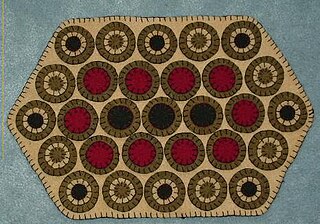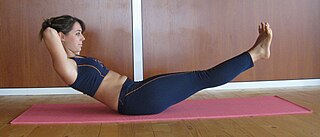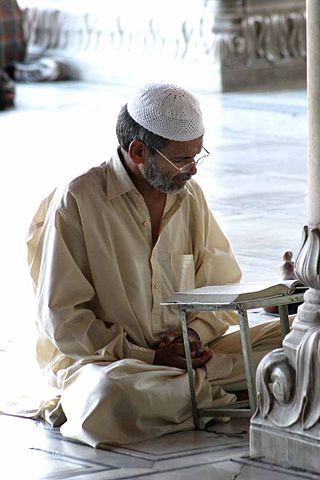
A rug is a piece of cloth, similar to a carpet, but it does not span the width of a room and is not attached to the floor. It is generally used as a floor covering, or as a decorative feature.

A carpet is a textile floor covering typically consisting of an upper layer of pile attached to a backing. The pile was traditionally made from wool, but since the 20th century synthetic fibers such as polypropylene, nylon, or polyester have often been used, as these fibers are less expensive than wool. The pile usually consists of twisted tufts that are typically heat-treated to maintain their structure. The term carpet is often used in a similar context to the term rug, but rugs are typically considered to be smaller than a room and not attached to the floor.

A mat is a hard floor covering that generally is placed on a floor or other flat surface. Mats serve a range of purposes including:

A kilim is a flat tapestry-woven carpet or rug traditionally produced in countries of the former Persian Empire, including Iran, the Balkans and the Turkic countries. Kilims can be purely decorative or can function as prayer rugs. Modern kilims are popular floor coverings in Western households.

A prayer rug or prayer mat is a piece of fabric, sometimes a pile carpet, used by Muslims, some Christians, especially in Orthodox Christianity and some Baha'i during prayer.
The Rub el Hizb is an Islamic symbol in the shape of an octagram, represented as two overlapping squares. While its main utility today is to mark a division inside some copies of the Quran to facilitate recitation, it has originally featured on a number of emblems and flags in the past and continues to do so today. It has traditionally been called the Seljuk Star.

Rug hooking is both an art and a craft where rugs are made by pulling loops of yarn or fabric through a stiff woven base such as burlap, linen, or rug warp. The loops are pulled through the backing material by using a crochet-type hook mounted in a handle for leverage. In contrast latch-hooking uses a hinged hook to form a knotted pile from short, pre-cut pieces of yarn.
Uzbek Julkhyr is a type of rug that was made primarily in Uzbekistan.

A penny rug is a decoration made of stitched-together coin-shaped fabric scraps.

Yoga mats are specially fabricated mats used to prevent hands and feet slipping during asana practice in modern yoga as exercise. An early variety made of rubber carpet underlay, pioneered by the yoga teacher Angela Farmer in 1982, was called a sticky mat. Before modern times, meditative yoga and hatha yoga were practised on bare ground, sometimes with a deer or tiger skin rug. Modern mats suitable for energetic forms of yoga are made of plastic, rubber, and sometimes other materials including hessian and cork, trading off cost, comfort, grip, and weight. The yoga mat has been called "One of the most ubiquitous symbols of yoga's commercialization".

The Taqiyah, also known as tagiyah or araqchin, is a short, rounded skullcap worn by Muslim men. In the United States and the United Kingdom, it is also referred to as a "kufi", although the Kufi typically has more of an African connotation. Aside from being an adornment, the taqiyah has deeply ingrained significance in Islamic culture, reflecting the wearer's faith, devotion, and sometimes regional identity. While the taqiyah is deeply rooted in Muslim traditions, its use varies based on cultural context rather than strict religious guidelines.
An Afghan rug is a type of handwoven floor-covering textile traditionally made in the northern and western areas of Afghanistan, mainly by Afghan Turkmens and Uzbeks. The industry is being expanded to all 34 provinces of Afghanistan.

Ala kiyiz or tekemet is an ornamenting style for textile floor- or wallcovering made by pressing wet, soaped wool of various colours together to make it felt. The chemical process of felting transforms the loose woolen fibers into a thick cloth. The felt carpet-making technique is a traditional folk art among the nomadic farming Kazakh, Kyrgyz and Mongolian peoples of the Tien Shan mountains and the steppes in Central Asia for over two and a half thousand years. From the various methods of ornamenting, ala kiyiz is among the widest spread, with shyrdak.

Armenians wove Lilihans in Lilihan village in what used to be called Kamareh district in Iran. The term Lilihan is better known in the US, in Europe it is not as widely used.

The boteh, is an almond or pine cone-shaped motif in ornament with a sharp-curved upper end. Though of Persian origin, it is very common and called buta in India, Azerbaijan, Turkey and other countries of the Near East. Via Kashmir shawls it spread to Europe at least in 19th century, where patterns using it are known since 1960s as paisleys, as Paisley, Renfrewshire in Scotland was a major centre imitating them.

Mike Bagley is an American motorsports commentator who works for the Motor Racing Network. He is the secondary turn announcer for MRN and has worked for the radio network since 1992 and became a turn announcer in 1998. Since 2008, Bagley has been a co-host of the nationally syndicated Sirius XM show The Morning Drive on Sirius XM NASCAR Radio.

Uzbek carpet is one of the best-known handmade carpets produced by Uzbeks. Carpet weaving, being one of the types of Uzbek arts and crafts, is inextricably linked with other kinds of Uzbek arts and crafts, continuing the tradition of other types of national fine art. Originally carpet in Uzbekistan is flourishing in such villages as Qamashi, Mirichkar and Dzheynau in Qashqadaryo Region.

Kashmiri handicrafts is a traditional art of Kashmiri people and artisans who make, craft, and decorate objects by hand. Ganderbal, and Budgam are the main districts in central Kashmir which have been making handicrafts products since ages. The rest of its districts, including Srinagar, Ganderbal, and Budgam are best known for their cultural heritage which includes the handicraft industry in Jammu and Kashmir, India. Embroidery is an integral part of many Kashmiri handicrafts, shawls, carpets and Kashmiri ladies pheran are adorned with intricate embroideries or flower styles made of thin metal threads and this kind of embroidery is known as 'Tille' in Kashmiri language. Embroidery work is done by both men in women in the region conventionally.

The Ruger Wrangler is a single-action rimfire revolver produced by Sturm, Ruger & Co. Chambered for .22 Long Rifle cartridges, it was announced in April 2019. The revolver makes extensive use of aluminum and zinc castings for ease of manufacturability, and also has an unfluted cylinder and uses metal injection molded components for further cost reduction. The Wrangler's price point has been described as "very attractive", and is less than half the MSRP of Ruger's Single-Six and Bearcat models.
Thrumming is a technique in which small pieces of wool or yarn (thrums) are pulled through fabric to create a wooly layer. The term thrum originally referred specifically to worthless pieces of warp thread which remained after weaving a piece of fabric using a loom, though its meaning has since broadened to include any small pieces of wool or thread which are used in a similar way.
















